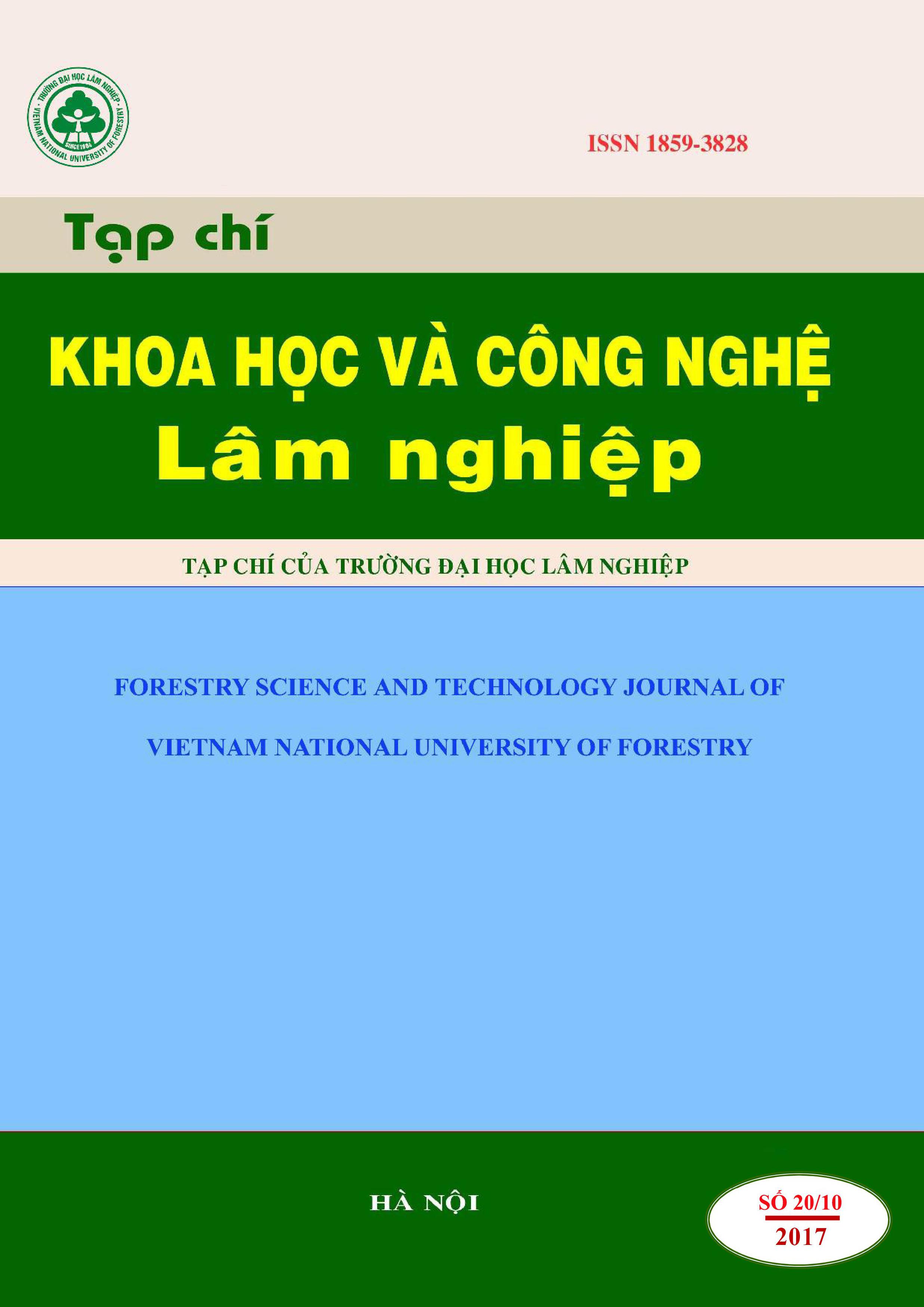ẢNH HƯỞNG CỦA ĐỘ ẨM ĐẾN SỰ BIẾN ĐỔI NHIỆT ĐỘ BÊN TRONG VÁN TRONG QUÁ TRÌNH ÉP NHIỆT CAO TẦN VÁN ÉP KHỐI TRE
Từ khóa:
Độ ẩm, hàm lượng keo, nhiệt độ, thời gian ép nhiệt cao tần, ván ép khối treTóm tắt
Nghiên cứu sử dụng ván tre ép khối làm vật liệu nghiên cứu, ván tre được ép nhiệt cao tần dưới các điều kiện độ ẩm nguyên liệu khác nhau, trong quá trình ép nhiệt cao tần ván ép khối tre tiến hành đo sự biến đổi nhiệt độ bên trong của ván, từ đó phân tích và đưa ra quy luật biến đổi nhiệt độ bên trong ván theo độ ẩm. Kết quả nghiên cứu cho thấy, trong phạm vi điều kiện thí nghiệm, nhiệt độ của ván tăng cao rõ ràng khi độ ẩm của thanh tre nguyên liệu tăng từ 6 - 18%, hàm lượng keo dán 300 g/m2. Trong quá trình tăng nhiệt độ có thể phân thành 2 giai đoạn là giai đoạn tăng nhiệt nhanh và giai đoạn tăng nhiệt chậm. Trong giai đoạn tăng nhiệt nhanh, nhiệt độ bên trong của ván tăng cao theo sự tăng dần của độ ẩm thanh tre nguyên liệu. Trong giai đoạn tăng nhiệt chậm, độ ẩm thanh tre nguyên liệu ảnh hưởng rất ít đến tốc độ tăng nhiệt độ bên trong ván, tốc độ tăng nhiệt của lớp giữa giảm dần khi thời gian gia nhiệt tăng lên. Thông qua kết quả phân tích của thí nghiệm, nghiên cứu đã đưa ra điều kiện công nghệ ép nhiệt cao tần ván ép khối tre với các thông số: hàm lượng keo 300 g/m2, độ ẩm thanh tre 12%, thời gian ép nhiệt cao tần 10 phút.
Tài liệu tham khảo
Chen, Y.P., Wang, J.L., Li, C.S., Wang, Z.T. (2007). The application of high-frequency heating technology in wood bonding process [J]. Wood Processing Mechinery, (5): 37- 41.
Wu, Z.H. (1994). Application of Radio-Frequency Heating Technology in the Wood – Working Industry[J]. World Forestry Research, (6): 30-36.
Wu, Z. H (1991). Temperature Measurement duringRadio-Frequency heating gluing process[J]. Wood working Machinery, (2): 53-55.
Liu, X., Zhang, Y., Li, W.D., Jia, C. (2013). Effect of moisture content on heating transfering during plying hot pressing[J]. China Forestry Science and Technology, 27(1): 32-34.
Yu,M.C., Rao, J.P., Xie, Y.Q. (2011). Moisture and temperature distribution of MDF mat after microwave preheating[J]. Journal of Northeast Forestry University, 39(6): 47-48, 64.
Lei, Y.F. (2005). Study on the heat-transfer properties of flakeboard during hot pressing[D]. Beijing: Beijing Forestry University.
Chen, T.Q. (2006). Study on the variation law of temperature, air pressure and moisture content of flakeboard during hot pressing[D]. Beijing: Beijing Forestry University,
Li, C.C. (2008). The relation of the temperature of the center layer of mat in the hot pressing process to mechanical performance of MDF[D]. Changsha: Central South University of Forestry and Technology.
Du, C.G. (2005). Research on the fundamentals of internal temperature distribution and factors involved of flakeboard during hot pressing[D]. Beijing: Beijing Forestry University
Xie, L.S., Zhao, R.J., Zhang, Q.S. (2002). Theoretical Study of Hot Pressing Time of Wood-Based Panels I[J]. Journal of Central South Forestry University, 22(2): 92-95.
Zombori, B.G., Kamke, F.A., Watson, L.T. (2003). Simulationoftheinternalconditions during the hot-Pressing Proeess[J]. Wood and Fiber Science, 35(l): 2-23.
Xie, L.S, Zhao, R.J., Zhang, Q.S. (2003). Theoretical Study of Hot Pressing Time of Wood-Based Panels II[J]. Journal of Central South Forestry University, 23(2): 66-70.
Xie, L.S., Zhao, R.J., Zhang, Q.S. (2004). Theoretical Study of Hot Pressing Time of Wood-Based Panels III[J]. Journal of Central South Forestry University, 24(l): 60-62
Du C.G., Chen, T.Q., Chang, J.M. (2004). Current Situation and Future on Research of Heat and Mass Transfer in Particleboard During Hot Pressing[J]. China Forest Products Industry, 31(5): 10-14.
Anagnostopoulou-Konsta, A., Pissis.P. (1988). The influence of humidity onthe dielectric properties of wood. Fifth International Conference onDielectric Materials, Measurements and Applications: 105-108.
Torgovnikov, G.I. (1994). Dielectric properties of wood and wood-basedmaterials. European Journal of Wood and Wood Products, 52(2): 196-201.
William, L.J. (1975). Dielectric properties of wood and hardboard: variation with temperature, frequency, moisture contentand grainorientation. USDA Forest Service Research Paper FPL, 245: 1-35.
Chen, Y.P., Wang, J.L., Li, C.S., Wang, J.P. (2011). Variation of temperature inside the mats for wood-based panels by high-frequency hot pressing process[J]. Scientia Silvae Sinicae, 47(1): 113-117.
陈新谋, 刘悟日 (1979). 高预介质加热技术[M].科技出版社.
成俊卿 (1985). 木材学[M]. 北京中国林业出版社
Shi, W.C., Li, H.X. (1984). Relationship between the Dielectric constant and Moisture content of Wood – The Blending Rules of Wood Dielectric constatn[J]. Journal of North-Eastern Forestry Institute, 12(4): 131-140.









